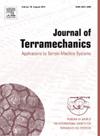将颗粒阻力理论推广到粘性粉状介质
IF 3.7
3区 工程技术
Q3 ENGINEERING, ENVIRONMENTAL
引用次数: 0
摘要
侵入颗粒介质在自然和工程环境中很常见(例如在动物运动和行星着陆期间)。虽然在干燥的非粘性颗粒材料中复杂形状的侵入已经得到了很好的研究,但对粘性粉末中的侵入知之甚少。颗粒阻力理论(RFT)是一种降阶摩擦流体模型,通过假设作用在任意形状的侵入物上的角相关元素应力的线性叠加,定量预测干燥、非粘性颗粒介质中的侵入力。在这里,我们将RFT的适用性扩展到粘性干粉,使在入侵过程中对复杂形状的力进行定量建模。为此,我们首先对干燥的玉米淀粉粉进行入侵实验,以产生应力函数。这些应力与非粘性介质相似;然而,我们观察到与非粘性介质相比,粘性粉末对水平侵入的抵抗力相对较高。我们使用该模型来识别几何形状,增强抵抗侵入的粘性粉末,旨在最大限度地减少下沉。我们的计算得到了实验验证的支持,表明平面在各种入侵角度上产生的应力最大,而曲面对垂直入侵的阻力最大。因此,我们的模型可以促进在这种环境下运行的机器人平台(例如地外着陆器)的优化设计和运动策略。本文章由计算机程序翻译,如有差异,请以英文原文为准。
Extending granular resistive force theory to cohesive powder-scale media
Intrusions into granular media are common in natural and engineered settings (e.g. during animal locomotion and planetary landings). While intrusion of complex shapes in dry non-cohesive granular materials is well studied, less is known about intrusion in cohesive powders. Granular resistive force theory (RFT) — a reduced-order frictional fluid model — quantitatively predicts intrusion forces in dry, non-cohesive granular media by assuming a linear superposition of angularly dependent elemental stresses acting on arbitrarily shaped intruders. Here we extend RFT’s applicability to cohesive dry powders, enabling quantitative modeling of forces on complex shapes during intrusion. To do so, we first conduct intrusion experiments into dry cornstarch powder to create stress functions. These stresses are similar to non-cohesive media; however, we observe relatively higher resistance to horizontal intrusions in cohesive powder compared to non-cohesive media. We use the model to identify geometries that enhance resistance to intrusion in cohesive powder, aiming to minimize sinkage. Our calculations, supported by experimental verification, suggest that a flat surface generates the largest stress across various intrusion angles while a curved surface exhibits the largest resistive force to vertical intrusion. Our model can thus facilitate optimizing design and movement strategies for robotic platforms (e.g. extraterrestrial landers) operating in such environments.
求助全文
通过发布文献求助,成功后即可免费获取论文全文。
去求助
来源期刊

Journal of Terramechanics
工程技术-工程:环境
CiteScore
5.90
自引率
8.30%
发文量
33
审稿时长
15.3 weeks
期刊介绍:
The Journal of Terramechanics is primarily devoted to scientific articles concerned with research, design, and equipment utilization in the field of terramechanics.
The Journal of Terramechanics is the leading international journal serving the multidisciplinary global off-road vehicle and soil working machinery industries, and related user community, governmental agencies and universities.
The Journal of Terramechanics provides a forum for those involved in research, development, design, innovation, testing, application and utilization of off-road vehicles and soil working machinery, and their sub-systems and components. The Journal presents a cross-section of technical papers, reviews, comments and discussions, and serves as a medium for recording recent progress in the field.
 求助内容:
求助内容: 应助结果提醒方式:
应助结果提醒方式:


